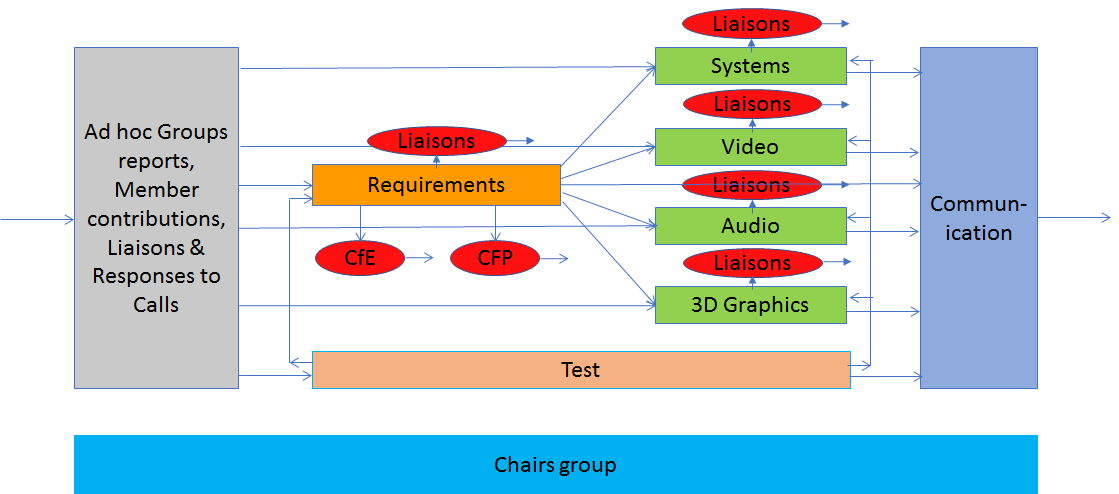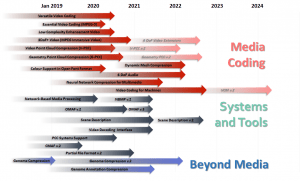Introduction
Most readers will answer yes to the question asked in the title. Indeed, very often we see that success of a human organisation breeds success. Until, I mean, the machine that looked like it could produce results forever “seizes”. But don’t look elsewhere for the causes of failure: it’s not the machine, the causes are humans inside and/or outside.
In an age when things move fast and change, MPEG has been in operation for three decades. Its standards have achieved and continue achieving enormous success serving billions of human beings: consumers, service providers and manufacturers.
This article makes some considerations on the best way for MPEG success to breed success – unless success to breed failure is the goal. Apparently unrelated considerations are made in The Imperial Diet is facing a problem.
Recalling the MPEG story
MPEG started in 1988 as an “experts group” with the task to develop video coding standards for storage media at a rate of about 1.5 Mbit/s, like the compact disc (CD). This was because, in the second half of the 1980’s, the Consumer Electronics and telco industries imagined that interactive video – local or via the network – was a killing application.
Within 6 months MPEG had already started working on audio coding because – it looks obvious now, but it was not so obvious at that time – if you have video you also need audio and, if you do not compress stereo audio at 1.41 Mbit/s, the output bitrate of a CD, there will be no space left for video. In another 6 months MPEG had started working on “systems” aspects, those allowing a receiver to reproduce synchronised audio and video information.
These were the first steps in the MPEG drive to make standards that had no “holes” for implementors. Thanks to these efforts, the scope of use of MPEG standards, still within the scope of “coding of moving pictures and audio”, have expanded like wildfire: starting from coding of moving pictures at 1.5 Mbit/s and expanded to more video, audio, transport, protocols, API and more. With its standards, MPEG is handling all technologies that facilitate enhanced use of digital media.
The MPEG expansion is a joyous phenomenon that has created an expanding global brotherhood of digital media researchers – in industry and academia – for which MPEG and its standards are the motivation for more research. If research results are good, they can make their way into some MPEG standard.
MPEG needs a structure
Clearly you cannot have hundreds of people discussing such a broad scope of technologies at the same time and place. You can split the work because technologies can be considered independent up to a point. Eventually, however, like in a puzzle, all pieces have to find a place in the global picture. The MPEG structure has been implemented to allow the creation of ever more complex puzzles.
In its 31 years of activity MPEG has developed a unique organisation capable of channeling the efforts of thousands of researchers working at any one time on MPEG standards – only a fraction of which actually show up at MPEG meetings – into the suites of integrated standards that industry uses to churn out products and services worth trillions of USD a year.
The figure below depicts the MPEG structure from the viewpoint of the standard development workflow.

The MPEG workflow
Typically, new ideas come from members’ contributions, but can also be generated from inside MPEG. The Requirements group assesses and develops ideas and may go as far as to request “evidence” of existence and performance of technologies (Calls for Evidence – CfE) or actual “proposals” for fully documented technologies (Call for Proposals – CfP).
MPEG has never had a “constituency” because it develops horizontal standards cutting across industries. It has established liaisons with tens of industries and communities through their standards committees or trade associations. We call many of them as “client industries” in the sense that they provide their requirements to MPEG against which MPEG produces standards. At every meeting, several tens of input liaisons are received and about the same amount of output liaisons are issued.
Many CfPs cover a broad range of technologies that are within the competence of the different MPEG groups. The adequacy of submitted technologies is tested by the Test Group. The submitted proposals and the test results are provided to the appropriate technical groups – Systems, Video, Audio and 3D Graphics.
The Chairs group includes the chairs of all groups. It has the task to assess the progress of work, uncover bottlenecks, identify needs to discuss shared interests between groups and organise joint meetings to resolve issues.
An MPEG week is made of intense days (sometimes continuing until midnight). Coordinated work, however, does not stop when the meeting ends. At that time MPEG establishes tens of ad hoc groups with precise goals for collaborative development to be reported at the next meeting.
The Communication group has the task to keep the world informed of the progress of the work and to produce white papers, investigations and technical notes.
MPEG is not an empire
From the above, one may think that MPEG is an empire, but it is not. MPEG is a working group, the lowest layer of the ISO hierarchy, in charge of developing digital media standards. It formally reports to a Subcommittee called SC 29 but, as I have explained in Dot the i’s and cross the t’s, SC 29 has ended up with a laissez-faire attitude that has allowed MPEG to autonomously develop strategy, organisational structure and network of client industries. MPEG standards have given client industries the tools to make their analogue infrastructures digital and, subsequently, to leverage successive generations of standard digital media technologies to expand their business. With some success, one could say.
The MPEG organisation is robust. Virtually the same organisation has been in place since – 25 years ago – MPEG had an attendance of 300. Groups have come and gone and the structure currently in operation has been refined multiple times in response to actual needs. Changes have been effected, and there will be more changes in the future. However, they all have been and, as far as I can see, will be incremental adaptations, to perfect one aspect or another of the structure. With this structure, more than 150 standards have been produced, some of which have been wildly successful.
MPEG can count on three assets: the logic of the structure, the experience gained in all those years, its membership and its client industries. With these, MPEG success can breed more success in the years to come.
The Imperial Diet is facing a problem
I said before that MPEG is not an empire. In the imperial context of the Holy Roman Empire, MPEG could be defined as a Margraviate in charge of defending and extending a portion of the frontiers of the Empire. A Margraviate reported to a Kingdom who reported to the Imperial Diet.
Now, let’s suppose that the Imperial Diet has requested the S Kingdom to review the status of its two J and M Margraviates and propose a new arrangement. The main element in the decision is the size of the two Margraviates: 10% of the territory of the S Kingdom for the J Margraviate and 90% for the M Margraviate. Ruling out other fancy ideas, the S Kingdom has two options: request that the M Margraviate be elevated to Kingdom status or create a few smaller Margraviates inside the S Kingdom out of the M Margraviate.
There is a problem, though, if the M Margraviate is cut in smaller Margraviates: the Margraviates of the Holy Roman Empire are not domino game pawns. For decades the M Margraviate has fought hard extending its territory – hence the Holy Roman Empire’s territory – to lands that until then were occupied by unruly tribes. It has been successful in its endeavours because it had large armies with different skills: archers, knights, foot soldiers and more. By skillfully coordinating these specialised troops, the M Margraviate was able to conquer new lands and make them faithful fiefdoms.
But there is another important consideration: there are wild hordes coming from the steppes of Central Asia with a completely new warfare technique. Some armies of M Margraviate are having a hard time dealing with them, even though they are learning a trick or two to fight back.
How could the new armies of the different Margraviates created out of the M Margraviate defend – never mind extend – the frontier, when the S Kingdom does not know the territory, having lived all time in its castle, and has never led an army?
The Holy Roman Empire lasted 1,000 years. There is no doubt that the Imperial Diet would make the M Margraviate a Kingdom keeping its armies and structure unchanged. Warfare is a serious business and the effective defence of the frontiers is the priority.
Conclusions
Fortunately, today there is no Margraviates and Kingdoms anymore, much less the Holy Roman Empire. There are also no new territories to conquer by force of arms and there are no frontiers to defend against rebellious hordes.
I realise now that at the beginning of this article I have promised that I would make some considerations on the best way for MPEG success to breed success and not failure. Maybe I will do that next time.
Posts in this thread
- Does success breed success?
- Dot the i’s and cross the t’s
- The MPEG frontier
- Tranquil 7+ days of hard work
- Hamlet in Gothenburg: one or two ad hoc groups?
- The Mule, Foundation and MPEG
- Can we improve MPEG standards’ success rate?
- Which future for MPEG?
- Why MPEG is part of ISO/IEC
- The discontinuity of digital technologies
- The impact of MPEG standards
- Still more to say about MPEG standards
- The MPEG work plan (March 2019)
- MPEG and ISO
- Data compression in MPEG
- More video with more features
- Matching technology supply with demand
- What would MPEG be without Systems?
- MPEG: what it did, is doing, will do
- The MPEG drive to immersive visual experiences
- There is more to say about MPEG standards
- Moving intelligence around
- More standards – more successes – more failures
- Thirty years of audio coding and counting
- Is there a logic in MPEG standards?
- Forty years of video coding and counting
- The MPEG ecosystem
- Why is MPEG successful?
- MPEG can also be green
- The life of an MPEG standard
- Genome is digital, and can be compressed
- Compression standards and quality go hand in hand
- Digging deeper in the MPEG work
- MPEG communicates
- How does MPEG actually work?
- Life inside MPEG
- Data Compression Technologies – A FAQ
- It worked twice and will work again
- Compression standards for the data industries
- 30 years of MPEG, and counting?
- The MPEG machine is ready to start (again)
- IP counting or revenue counting?
- Business model based ISO/IEC standards
- Can MPEG overcome its Video “crisis”?
- A crisis, the causes and a solution
- Compression – the technology for the digital age


